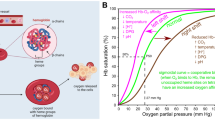We studied the effect of Fe2+ ions in polymerized hemoglobin (Krunidon blood substitute) and in molecular hemoglobin (Sigma) on OH• radical initiation in the Fenton system. It was found that polymerized hemoglobin, as a component of Krunidon preparation, in contrast to hemoglobin tetramer, did not intensify OH• radical generation. The oxidant potential of Krunidon was evaluated in vivo by measuring malondialdehyde level in dog blood plasma after repeated intravenous administration (5 days in a dose of 114 mg/kg) as a biomarker. Administration of the preparation did not significantly increased malondialdehyde content on days 1 and 4 after exposure and did not affect total protein content in blood plasma. Our findings suggest that polymerized hemoglobin in the Krunidon preparation exhibits no pro-oxidant activity and can be used as the basis for the development of non-oxygenic forms of blood substitutes.
Similar content being viewed by others
References
Zhiburt EB, Shestakov EA. Hemopure — hemoglobin-based oxygen carrier. Vestn. Nats. Med.-Khir. Tsentra im. N. I. Pirogova. 2012;7(2):74-81. Russian.
Ivannik BP, Riabchenko NI, Dzikovskaia LA, Khorokhorina VA, Riabchenko VI, Sin’kova RV, Grosheva IP, Degtiareva EV. Comparative efficiency of injurious action of radiation and stress on thymus and lipid peroxidation. Radiats. Biol. Radioekol. 2000;40(6):656-658. Russian.
Men’shchikova EB, Zenkov NK, Lankin VS, Bondar’ IA, Trufakin VA. Oxidative stress. Pathological conditions and diseases. Novosibirsk, 2008. Russian.
Goncharova AJ, Podgorodnichenko VK, Roziev RA, Khomichenok VV, Tsyb AF. Patent RU No. 2340354. Blood substitute with function of oxygen transfer. Bull. No. 34. Published December 10, 2008.
Ryabchenko NI, Ivannik BP, Ryabchenko VI, Dzikovskaya LA. The effect of ionizing radiation and administration of iron ions and their chelate complexes on oxidative status of the blood serum in rats. Radiats. Biol. Radioekol. 2011;51(2):229-232. Russian.
Selivanov EA, Pshenkina NN, Murzina EV, Sofronov GA, Khanevich MD, Sarychev VA. Current development and introduction of hemoglobin-based blood substitutes. Med. Akad. Zh. 2011;11(2):49-60. Russian.
Buehler PW, Baek JH, Lisk C, Connor I, Sullivan T, Kominsky D, Majka S, Stenmark KR, Nozik-Grayck E, Bonaventura J, Irwin DC. Free hemoglobin induction of pulmonary vascular disease: evidence for an inflammatory mechanism. Am. J. Physiol. Lung Cell. Mol. Physiol. 2012;303(4):L312-L326.
Deuel JW, Vallelian F, Schaer CA, Puglia M, Buehler PW, Schaer DJ. Different target specificities of haptoglobin and hemopexin define a sequential protection system against vascular hemoglobin toxicity. Free Radic. Biol. Med. 2015;89:931-943.
Gutteridge JM. Lipid peroxidation and antioxidants as biomarkers of tissue damage. Clin. Chem. 1995;41(12(2):1819-1828.
Hess JR. Review of modified hemoglobin research at Letterman: attempts to delinеate the toxicity of cell-free tetrameric hemoglobin. Artif. Cells Blood Substit. Immobil. Biotechnol. 1995;23(3):277-289.
Himmelfarb J, McMonagle E. Albumin is the major plasma protein target of oxidant stress in uremia. Kidney Int. 2001;60(1):358-363.
Jeney V, Eaton JW, Balla G, Balla J. Natural history of the bruise: formation, elimination, and biological effects of oxidized hemoglobin. Oxid. Med. Cell. Longev. 2013;2013. ID 703571. doi: https://doi.org/10.1155/2013/703571.
Kruszewski М. Labile iron pool: the main determinant of cellular response to oxidative stress. Mut. Res. 2003;531(1-2):81-92.
López-Alarcón C, Denicola A. Evaluating the antioxidant capacity of natural products: a review on chemical and cellularbased assays. Anal. Chim. Acta. 2012;763:1-10.
Roche M, Rondeau P, Singh NR, Tarnus E, Bourdon E. The antioxidant properties of serum albumin. FEBS Lett. 2008;582(13):1783-1787.
Author information
Authors and Affiliations
Corresponding author
Additional information
Translated from Byulleten’ Eksperimental’noi Biologii i Meditsiny, Vol. 166, No. 8, pp. 170-173, August, 2018
Rights and permissions
About this article
Cite this article
Dzikovskaya, L.A., Erimbetov, K.T., Grosheva, I.P. et al. Oxidant Potential of Krunidon In Vitro and In Vivo. Bull Exp Biol Med 166, 213–216 (2018). https://doi.org/10.1007/s10517-018-4316-2
Received:
Published:
Issue Date:
DOI: https://doi.org/10.1007/s10517-018-4316-2




